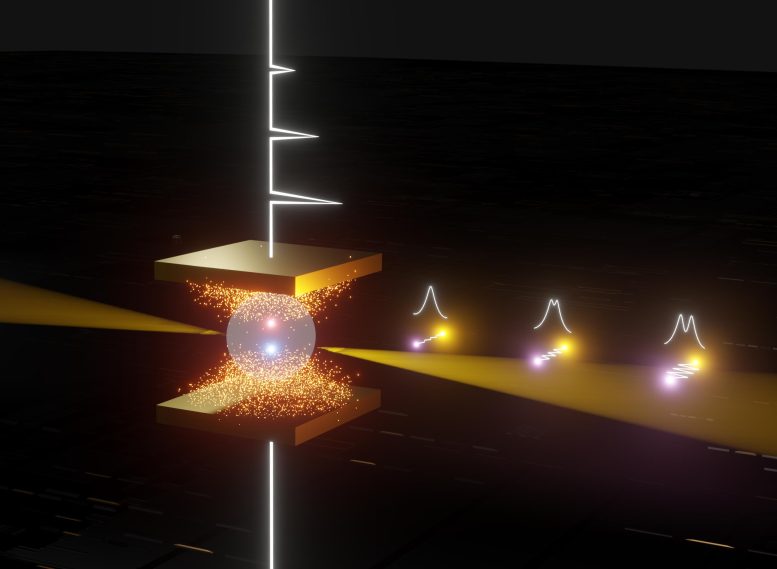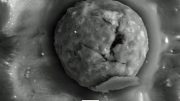
Image depicting the control of polariton particles using electric-field tip-enhanced strong coupling spectroscopy. Credit: POSTECH
POSTECH researchers have created a technique for controlling polaritons, which could lead to advancements in optical displays and various optoelectronic devices.
A research team consisting of Professor Kyoung-Duck Park and Hyeongwoo Lee, an integrated PhD student, from the Department of Physics at Pohang University of Science and Technology (POSTECH) has pioneered an innovative technique in ultra-high-resolution spectroscopy. Their breakthrough marks the world’s first instance of electrically controlling polaritons—hybridized light-matter particles—at room temperature.
Novel Characteristics of Polaritons
Polaritons are “half-light half-matter” hybrid particles, having both the characteristics of photons—particles of light—and those of solid matter. Their unique characteristics exhibit properties distinct from both traditional photons and solid matter, unlocking the potential for next-generation materials, particularly in surpassing performance limitations of optical displays. Until now, the inability to electrically control polaritons at room temperature on a single particle level has hindered their commercial viability.
Innovation in Spectroscopy
The research team has devised a novel method called “electric-field tip-enhanced strong coupling spectroscopy,” enabling ultra-high-resolution electrically controlled spectroscopy. This new technique empowers the active manipulation of individual polariton particles at room temperature.
This technique introduces a novel approach to measurement, integrating super-resolution microscopy previously invented by Prof. Kyoung-Duck Park’s team with ultra-precise electrical control. The resulting instrument not only facilitates stable generation of polariton in a distinctive physical state called strong coupling at room temperature but also allows for the manipulation of the color and brightness of the light emitted by the polariton particles through the use of an electric field.
Using polariton particles instead of quantum dots, key materials of QLED televisions, offers a notable advantage. A single polariton particle can emit light in all colors with significantly enhanced brightness. This eliminates the need for three distinct types of quantum dots to produce red, green, and blue light separately. Moreover, this property can be electrically controlled similar to conventional electronics.
In terms of academic significance, the team has successfully established and experimentally validated the quantum confined stark effect in the strong coupling regime, shedding light on a longstanding mystery in polariton particle research.
Impact on Optoelectronic Devices
The team’s accomplishment holds profound significance as it marks a scientific breakthrough paving the path for the next generation of research aimed at creating diverse optoelectronic devices and optical components based on polariton technology.
This breakthrough is poised to make a substantial contribution to industrial advancement, particularly in providing key source technology for the development of groundbreaking products within the optical display industry including ultra-bright and compact outdoor displays.
Hyeongwoo Lee, the lead author of the paper, emphasized the research’s importance, stating that it represents “a significant discovery with the potential to drive advancements across numerous fields including next-generation optical sensors, optical communications, and quantum photonic devices.”
Collaborative Research Efforts
The research utilized quantum dots fabricated by Professor Sohee Jeong’s team and Professor Jaehoon Lim’s team from Sungkyunkwan University. The theoretical model was crafted by Professor Alexander Efros of the Naval Research Laboratory while data analysis was conducted by Professor Markus Raschke’s team from the University of Colorado and Professor Matthew Pelton’s team from the University of Maryland. Yeonjeong Koo, Jinhyuk Bae, Mingu Kang, Taeyoung Moon, and Huitae Joo from POSTECH’s Physics Department carried out the measurement work.
This research has been recently published in Physical Review Letters, an international physics journal.
Reference: “Electrically Tunable Single Polaritonic Quantum Dot at Room Temperature” by Hyeongwoo Lee, Benjamin G. Whetten, Byong Jae Kim, Ju Young Woo, Yeonjeong Koo, Jinhyuk Bae, Mingu Kang, Taeyoung Moon, Huitae Joo, Sohee Jeong, Jaehoon Lim, Alexander L. Efros, Markus B. Raschke, Matthew Pelton and Kyoung-Duck Park, 25 March 2024, Physical Review Letters.
DOI: 10.1103/PhysRevLett.132.133001
This research was conducted with support from the Samsung Future Technology Incubation Program.









Be the first to comment on "Light-Matter Particle Breakthrough Could Change Displays Forever"